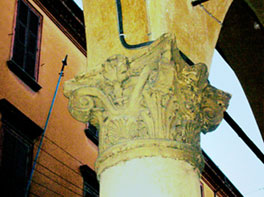|



 |
The Council ofTrent, which acted from 1545 to 1563, in
1547 temporarily transferred to Bologna in the Palazzo Sanuti-Bevilacqua.
Repressing the ambition of the Bolognese people in charge of S. Petronio
who wanted the church, still unfinished, to become an even greater church
than St. Peter's in Rome, Pope Pius IV, in 1561, ordered Carlo Borromeo
his Cardinal Legate, to build the Archiginnasio,
which was to be the unified centre for studies. The Archiginnasio
architect was Antonio
Morandi, called "Il Terribilia", a Bolognese artist
who planned a one storey building above the portico subsequently called
"del Pavaglione", (probably from "padiglione", to remember the stand or
pavilion which was in the adjoining square, opened in the 16th Century to
encourage the raw silk trade).
This portico, continuing the ones of the Palazzo dei Banchi and of the
Ospedale della Morte (this fast one was also added by the Terribilia),
became a public walk which connected Piazza Maggiore, the centre of the
"Studio" (up to the end of the 18th Century) to the present Piazza
Galvani, which had been opened, as they said, in that period. In this way
the schools - which in the 15th Century were in the Via delle Scuole, in
the street which became Via dell'Archiginnasio, and
in the Ospedale della Morte (now the Civic Archeology Museum) - in 1563
were re-united in a single central building under closer control on the
part of the authorities which were, by then, starting their counter
Reformation activities. In the initial period however,
the number of students, especially German ones, greatly increased.
In fact, although the Holy Office showed particular clemency here, in 1553
the Inquisition reached Bologna too. During the following century, inside
the Archiginnasio, above the Chapel of St. Maria
dei Bulgari, the Anatomical Theatre was built
entirely of wood; in it anatomy lessons, also open to the public, were
held.
|
|
b
o
l
o
g
n
a
u
r
b
a
n
p
l
a
n
|
